Planning for Growth
VerifiedAdded on 2023/02/03
|15
|5225
|57
AI Summary
This report discusses the key concepts of business growth, opportunities for growth using Ansoff's growth vector matrix, potential sources of funding, and business planning for growth. It also includes a critical evaluation of various growth options and strategies for small businesses. The case study focuses on Hampshire Tile Warehouse Ltd, a small business enterprise in the UK looking to expand its operations in Australia.
Contribute Materials
Your contribution can guide someone’s learning journey. Share your
documents today.

Planning for Growth
Secure Best Marks with AI Grader
Need help grading? Try our AI Grader for instant feedback on your assignments.
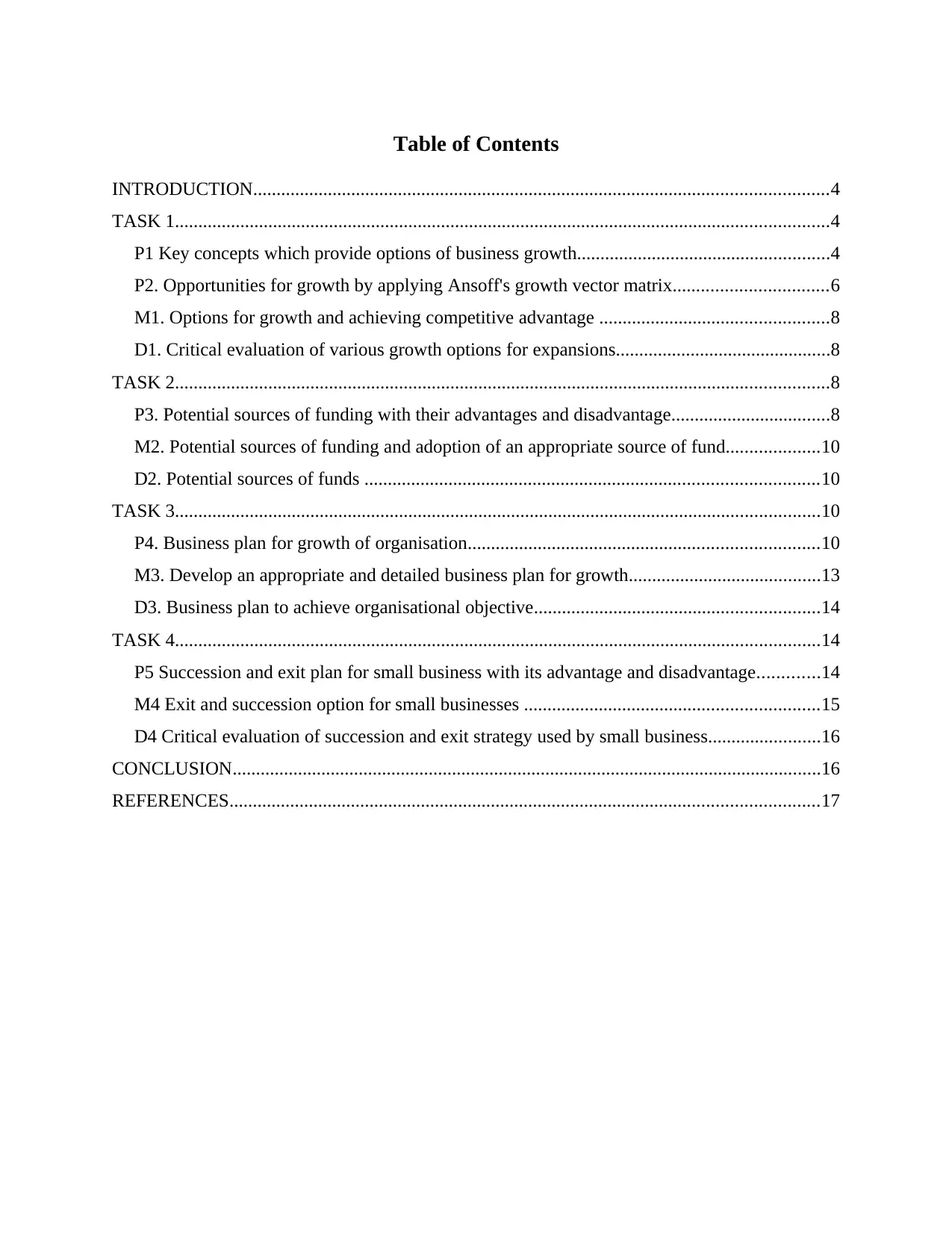
Table of Contents
INTRODUCTION...........................................................................................................................4
TASK 1............................................................................................................................................4
P1 Key concepts which provide options of business growth......................................................4
P2. Opportunities for growth by applying Ansoff's growth vector matrix.................................6
M1. Options for growth and achieving competitive advantage .................................................8
D1. Critical evaluation of various growth options for expansions..............................................8
TASK 2............................................................................................................................................8
P3. Potential sources of funding with their advantages and disadvantage..................................8
M2. Potential sources of funding and adoption of an appropriate source of fund....................10
D2. Potential sources of funds .................................................................................................10
TASK 3..........................................................................................................................................10
P4. Business plan for growth of organisation...........................................................................10
M3. Develop an appropriate and detailed business plan for growth.........................................13
D3. Business plan to achieve organisational objective.............................................................14
TASK 4..........................................................................................................................................14
P5 Succession and exit plan for small business with its advantage and disadvantage.............14
M4 Exit and succession option for small businesses ...............................................................15
D4 Critical evaluation of succession and exit strategy used by small business........................16
CONCLUSION..............................................................................................................................16
REFERENCES..............................................................................................................................17
INTRODUCTION...........................................................................................................................4
TASK 1............................................................................................................................................4
P1 Key concepts which provide options of business growth......................................................4
P2. Opportunities for growth by applying Ansoff's growth vector matrix.................................6
M1. Options for growth and achieving competitive advantage .................................................8
D1. Critical evaluation of various growth options for expansions..............................................8
TASK 2............................................................................................................................................8
P3. Potential sources of funding with their advantages and disadvantage..................................8
M2. Potential sources of funding and adoption of an appropriate source of fund....................10
D2. Potential sources of funds .................................................................................................10
TASK 3..........................................................................................................................................10
P4. Business plan for growth of organisation...........................................................................10
M3. Develop an appropriate and detailed business plan for growth.........................................13
D3. Business plan to achieve organisational objective.............................................................14
TASK 4..........................................................................................................................................14
P5 Succession and exit plan for small business with its advantage and disadvantage.............14
M4 Exit and succession option for small businesses ...............................................................15
D4 Critical evaluation of succession and exit strategy used by small business........................16
CONCLUSION..............................................................................................................................16
REFERENCES..............................................................................................................................17
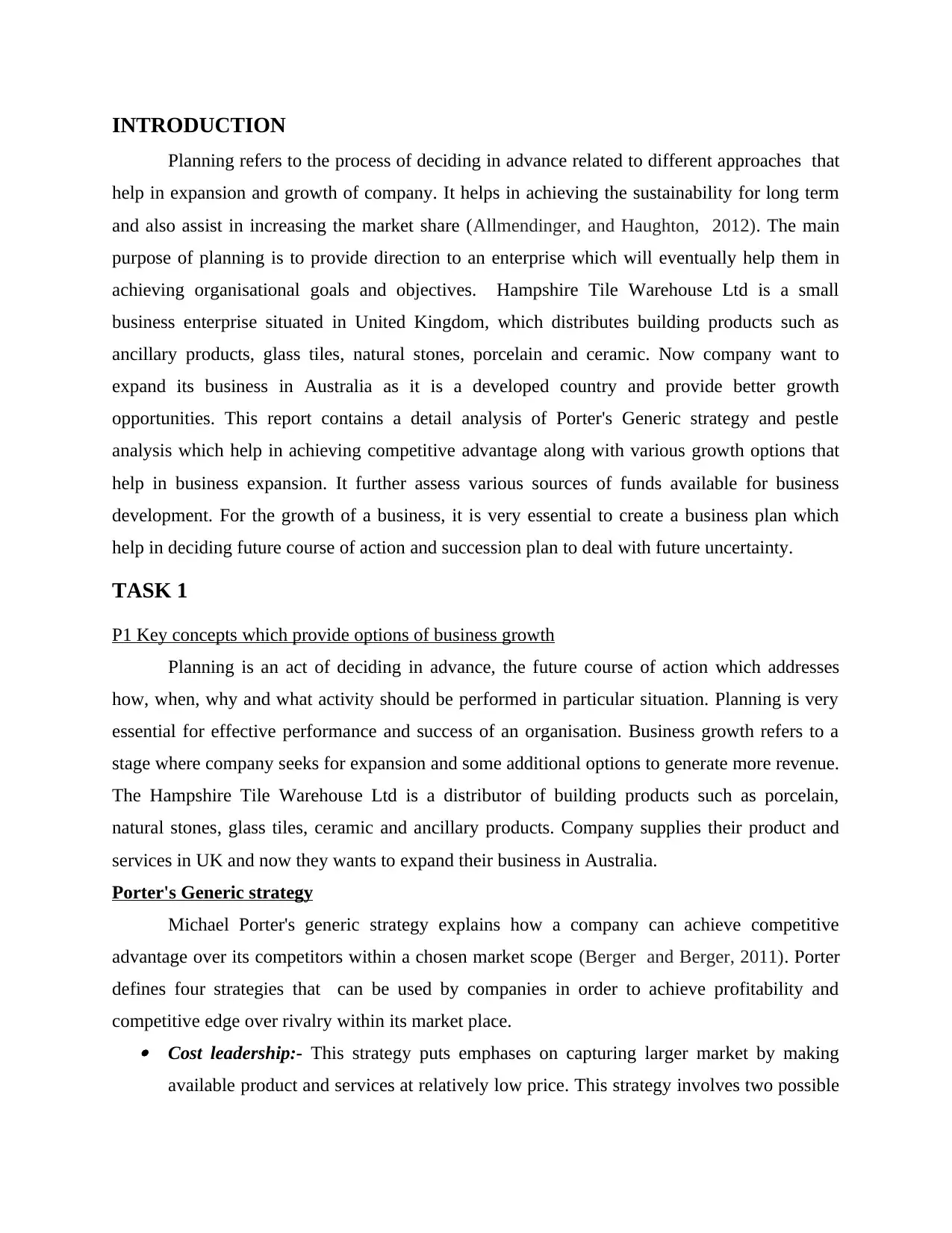
INTRODUCTION
Planning refers to the process of deciding in advance related to different approaches that
help in expansion and growth of company. It helps in achieving the sustainability for long term
and also assist in increasing the market share (Allmendinger, and Haughton, 2012). The main
purpose of planning is to provide direction to an enterprise which will eventually help them in
achieving organisational goals and objectives. Hampshire Tile Warehouse Ltd is a small
business enterprise situated in United Kingdom, which distributes building products such as
ancillary products, glass tiles, natural stones, porcelain and ceramic. Now company want to
expand its business in Australia as it is a developed country and provide better growth
opportunities. This report contains a detail analysis of Porter's Generic strategy and pestle
analysis which help in achieving competitive advantage along with various growth options that
help in business expansion. It further assess various sources of funds available for business
development. For the growth of a business, it is very essential to create a business plan which
help in deciding future course of action and succession plan to deal with future uncertainty.
TASK 1
P1 Key concepts which provide options of business growth
Planning is an act of deciding in advance, the future course of action which addresses
how, when, why and what activity should be performed in particular situation. Planning is very
essential for effective performance and success of an organisation. Business growth refers to a
stage where company seeks for expansion and some additional options to generate more revenue.
The Hampshire Tile Warehouse Ltd is a distributor of building products such as porcelain,
natural stones, glass tiles, ceramic and ancillary products. Company supplies their product and
services in UK and now they wants to expand their business in Australia.
Porter's Generic strategy
Michael Porter's generic strategy explains how a company can achieve competitive
advantage over its competitors within a chosen market scope (Berger and Berger, 2011). Porter
defines four strategies that can be used by companies in order to achieve profitability and
competitive edge over rivalry within its market place. Cost leadership:- This strategy puts emphases on capturing larger market by making
available product and services at relatively low price. This strategy involves two possible
Planning refers to the process of deciding in advance related to different approaches that
help in expansion and growth of company. It helps in achieving the sustainability for long term
and also assist in increasing the market share (Allmendinger, and Haughton, 2012). The main
purpose of planning is to provide direction to an enterprise which will eventually help them in
achieving organisational goals and objectives. Hampshire Tile Warehouse Ltd is a small
business enterprise situated in United Kingdom, which distributes building products such as
ancillary products, glass tiles, natural stones, porcelain and ceramic. Now company want to
expand its business in Australia as it is a developed country and provide better growth
opportunities. This report contains a detail analysis of Porter's Generic strategy and pestle
analysis which help in achieving competitive advantage along with various growth options that
help in business expansion. It further assess various sources of funds available for business
development. For the growth of a business, it is very essential to create a business plan which
help in deciding future course of action and succession plan to deal with future uncertainty.
TASK 1
P1 Key concepts which provide options of business growth
Planning is an act of deciding in advance, the future course of action which addresses
how, when, why and what activity should be performed in particular situation. Planning is very
essential for effective performance and success of an organisation. Business growth refers to a
stage where company seeks for expansion and some additional options to generate more revenue.
The Hampshire Tile Warehouse Ltd is a distributor of building products such as porcelain,
natural stones, glass tiles, ceramic and ancillary products. Company supplies their product and
services in UK and now they wants to expand their business in Australia.
Porter's Generic strategy
Michael Porter's generic strategy explains how a company can achieve competitive
advantage over its competitors within a chosen market scope (Berger and Berger, 2011). Porter
defines four strategies that can be used by companies in order to achieve profitability and
competitive edge over rivalry within its market place. Cost leadership:- This strategy puts emphases on capturing larger market by making
available product and services at relatively low price. This strategy involves two possible
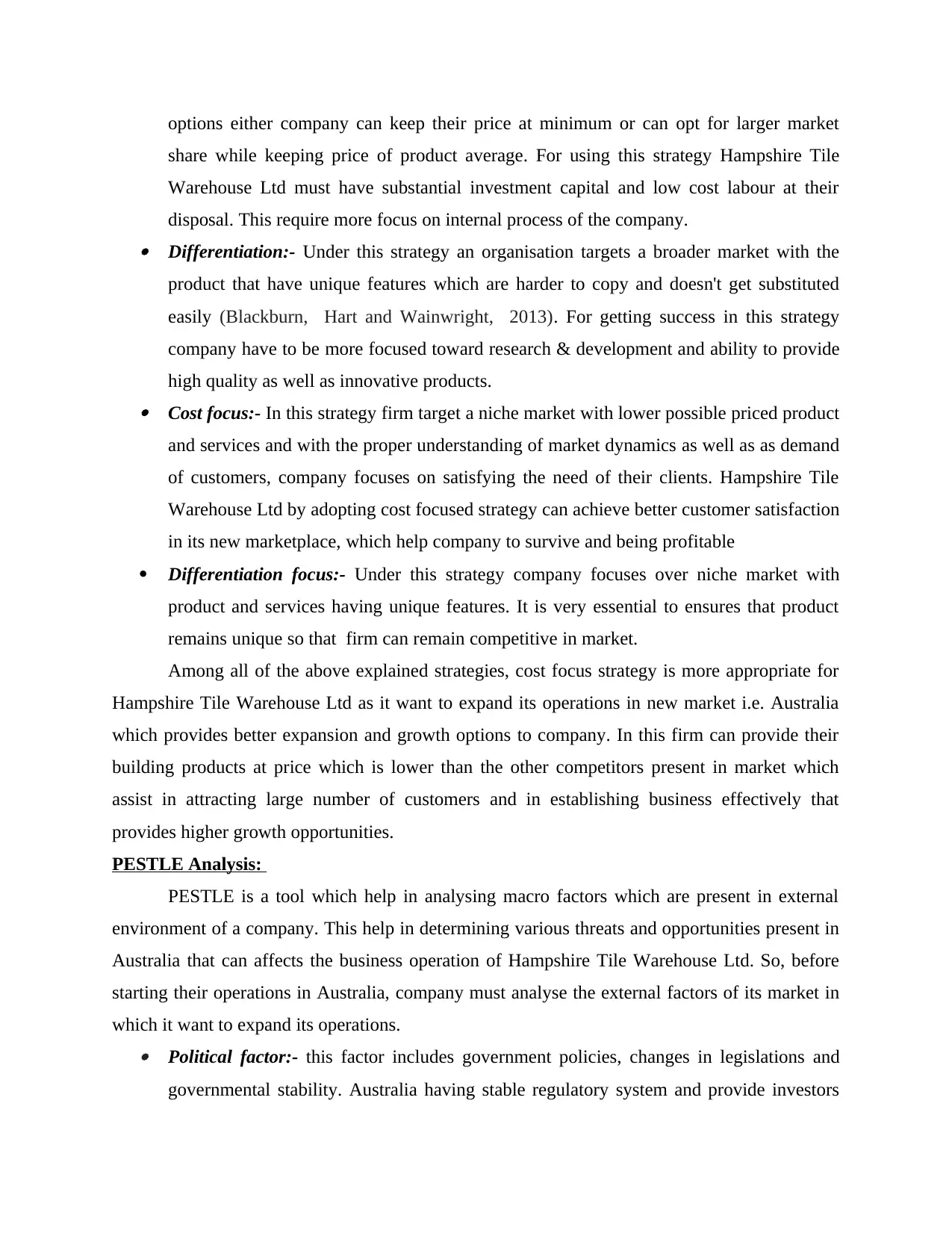
options either company can keep their price at minimum or can opt for larger market
share while keeping price of product average. For using this strategy Hampshire Tile
Warehouse Ltd must have substantial investment capital and low cost labour at their
disposal. This require more focus on internal process of the company. Differentiation:- Under this strategy an organisation targets a broader market with the
product that have unique features which are harder to copy and doesn't get substituted
easily (Blackburn, Hart and Wainwright, 2013). For getting success in this strategy
company have to be more focused toward research & development and ability to provide
high quality as well as innovative products. Cost focus:- In this strategy firm target a niche market with lower possible priced product
and services and with the proper understanding of market dynamics as well as as demand
of customers, company focuses on satisfying the need of their clients. Hampshire Tile
Warehouse Ltd by adopting cost focused strategy can achieve better customer satisfaction
in its new marketplace, which help company to survive and being profitable
Differentiation focus:- Under this strategy company focuses over niche market with
product and services having unique features. It is very essential to ensures that product
remains unique so that firm can remain competitive in market.
Among all of the above explained strategies, cost focus strategy is more appropriate for
Hampshire Tile Warehouse Ltd as it want to expand its operations in new market i.e. Australia
which provides better expansion and growth options to company. In this firm can provide their
building products at price which is lower than the other competitors present in market which
assist in attracting large number of customers and in establishing business effectively that
provides higher growth opportunities.
PESTLE Analysis:
PESTLE is a tool which help in analysing macro factors which are present in external
environment of a company. This help in determining various threats and opportunities present in
Australia that can affects the business operation of Hampshire Tile Warehouse Ltd. So, before
starting their operations in Australia, company must analyse the external factors of its market in
which it want to expand its operations. Political factor:- this factor includes government policies, changes in legislations and
governmental stability. Australia having stable regulatory system and provide investors
share while keeping price of product average. For using this strategy Hampshire Tile
Warehouse Ltd must have substantial investment capital and low cost labour at their
disposal. This require more focus on internal process of the company. Differentiation:- Under this strategy an organisation targets a broader market with the
product that have unique features which are harder to copy and doesn't get substituted
easily (Blackburn, Hart and Wainwright, 2013). For getting success in this strategy
company have to be more focused toward research & development and ability to provide
high quality as well as innovative products. Cost focus:- In this strategy firm target a niche market with lower possible priced product
and services and with the proper understanding of market dynamics as well as as demand
of customers, company focuses on satisfying the need of their clients. Hampshire Tile
Warehouse Ltd by adopting cost focused strategy can achieve better customer satisfaction
in its new marketplace, which help company to survive and being profitable
Differentiation focus:- Under this strategy company focuses over niche market with
product and services having unique features. It is very essential to ensures that product
remains unique so that firm can remain competitive in market.
Among all of the above explained strategies, cost focus strategy is more appropriate for
Hampshire Tile Warehouse Ltd as it want to expand its operations in new market i.e. Australia
which provides better expansion and growth options to company. In this firm can provide their
building products at price which is lower than the other competitors present in market which
assist in attracting large number of customers and in establishing business effectively that
provides higher growth opportunities.
PESTLE Analysis:
PESTLE is a tool which help in analysing macro factors which are present in external
environment of a company. This help in determining various threats and opportunities present in
Australia that can affects the business operation of Hampshire Tile Warehouse Ltd. So, before
starting their operations in Australia, company must analyse the external factors of its market in
which it want to expand its operations. Political factor:- this factor includes government policies, changes in legislations and
governmental stability. Australia having stable regulatory system and provide investors
Secure Best Marks with AI Grader
Need help grading? Try our AI Grader for instant feedback on your assignments.
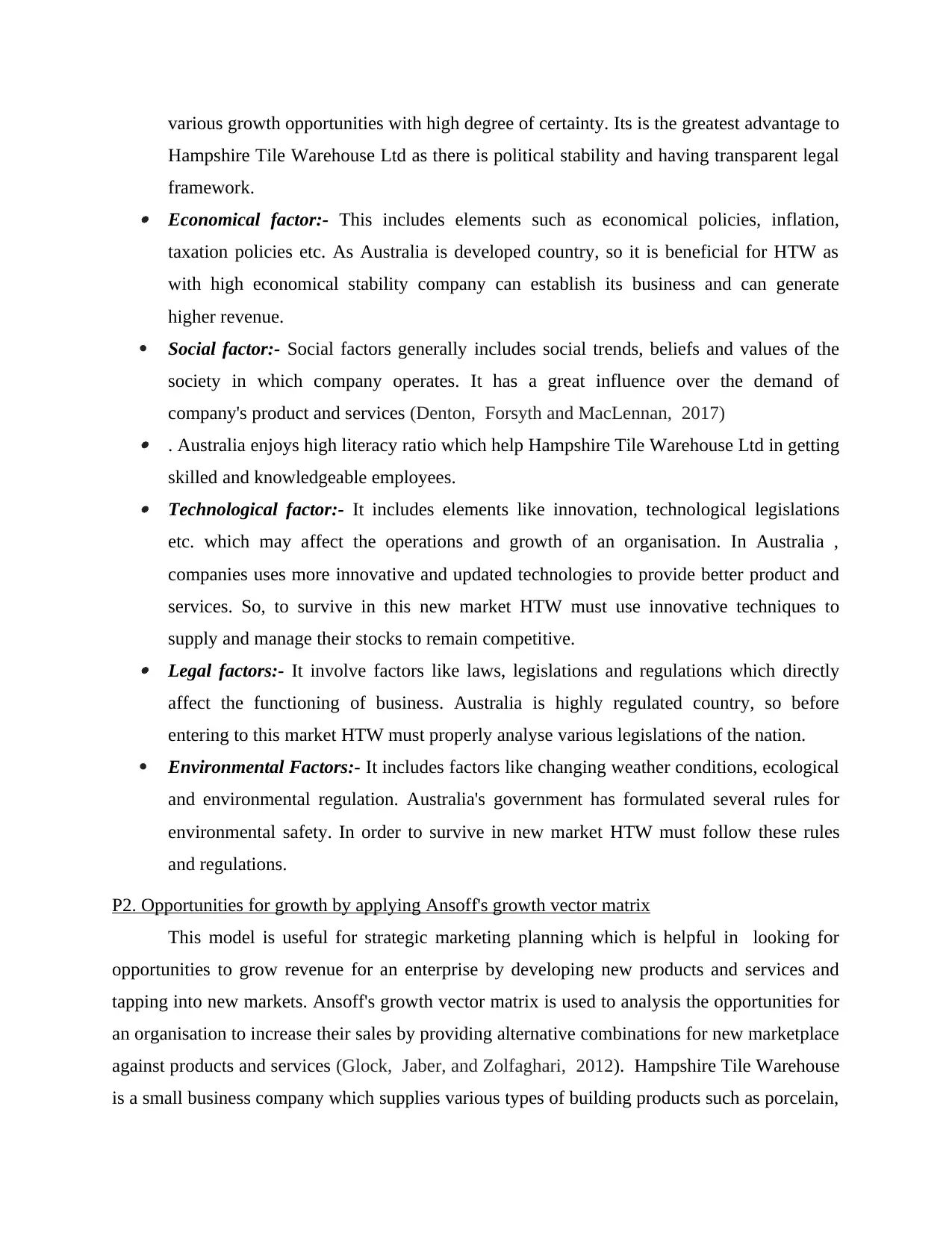
various growth opportunities with high degree of certainty. Its is the greatest advantage to
Hampshire Tile Warehouse Ltd as there is political stability and having transparent legal
framework. Economical factor:- This includes elements such as economical policies, inflation,
taxation policies etc. As Australia is developed country, so it is beneficial for HTW as
with high economical stability company can establish its business and can generate
higher revenue.
Social factor:- Social factors generally includes social trends, beliefs and values of the
society in which company operates. It has a great influence over the demand of
company's product and services (Denton, Forsyth and MacLennan, 2017) . Australia enjoys high literacy ratio which help Hampshire Tile Warehouse Ltd in getting
skilled and knowledgeable employees. Technological factor:- It includes elements like innovation, technological legislations
etc. which may affect the operations and growth of an organisation. In Australia ,
companies uses more innovative and updated technologies to provide better product and
services. So, to survive in this new market HTW must use innovative techniques to
supply and manage their stocks to remain competitive. Legal factors:- It involve factors like laws, legislations and regulations which directly
affect the functioning of business. Australia is highly regulated country, so before
entering to this market HTW must properly analyse various legislations of the nation.
Environmental Factors:- It includes factors like changing weather conditions, ecological
and environmental regulation. Australia's government has formulated several rules for
environmental safety. In order to survive in new market HTW must follow these rules
and regulations.
P2. Opportunities for growth by applying Ansoff's growth vector matrix
This model is useful for strategic marketing planning which is helpful in looking for
opportunities to grow revenue for an enterprise by developing new products and services and
tapping into new markets. Ansoff's growth vector matrix is used to analysis the opportunities for
an organisation to increase their sales by providing alternative combinations for new marketplace
against products and services (Glock, Jaber, and Zolfaghari, 2012). Hampshire Tile Warehouse
is a small business company which supplies various types of building products such as porcelain,
Hampshire Tile Warehouse Ltd as there is political stability and having transparent legal
framework. Economical factor:- This includes elements such as economical policies, inflation,
taxation policies etc. As Australia is developed country, so it is beneficial for HTW as
with high economical stability company can establish its business and can generate
higher revenue.
Social factor:- Social factors generally includes social trends, beliefs and values of the
society in which company operates. It has a great influence over the demand of
company's product and services (Denton, Forsyth and MacLennan, 2017) . Australia enjoys high literacy ratio which help Hampshire Tile Warehouse Ltd in getting
skilled and knowledgeable employees. Technological factor:- It includes elements like innovation, technological legislations
etc. which may affect the operations and growth of an organisation. In Australia ,
companies uses more innovative and updated technologies to provide better product and
services. So, to survive in this new market HTW must use innovative techniques to
supply and manage their stocks to remain competitive. Legal factors:- It involve factors like laws, legislations and regulations which directly
affect the functioning of business. Australia is highly regulated country, so before
entering to this market HTW must properly analyse various legislations of the nation.
Environmental Factors:- It includes factors like changing weather conditions, ecological
and environmental regulation. Australia's government has formulated several rules for
environmental safety. In order to survive in new market HTW must follow these rules
and regulations.
P2. Opportunities for growth by applying Ansoff's growth vector matrix
This model is useful for strategic marketing planning which is helpful in looking for
opportunities to grow revenue for an enterprise by developing new products and services and
tapping into new markets. Ansoff's growth vector matrix is used to analysis the opportunities for
an organisation to increase their sales by providing alternative combinations for new marketplace
against products and services (Glock, Jaber, and Zolfaghari, 2012). Hampshire Tile Warehouse
is a small business company which supplies various types of building products such as porcelain,
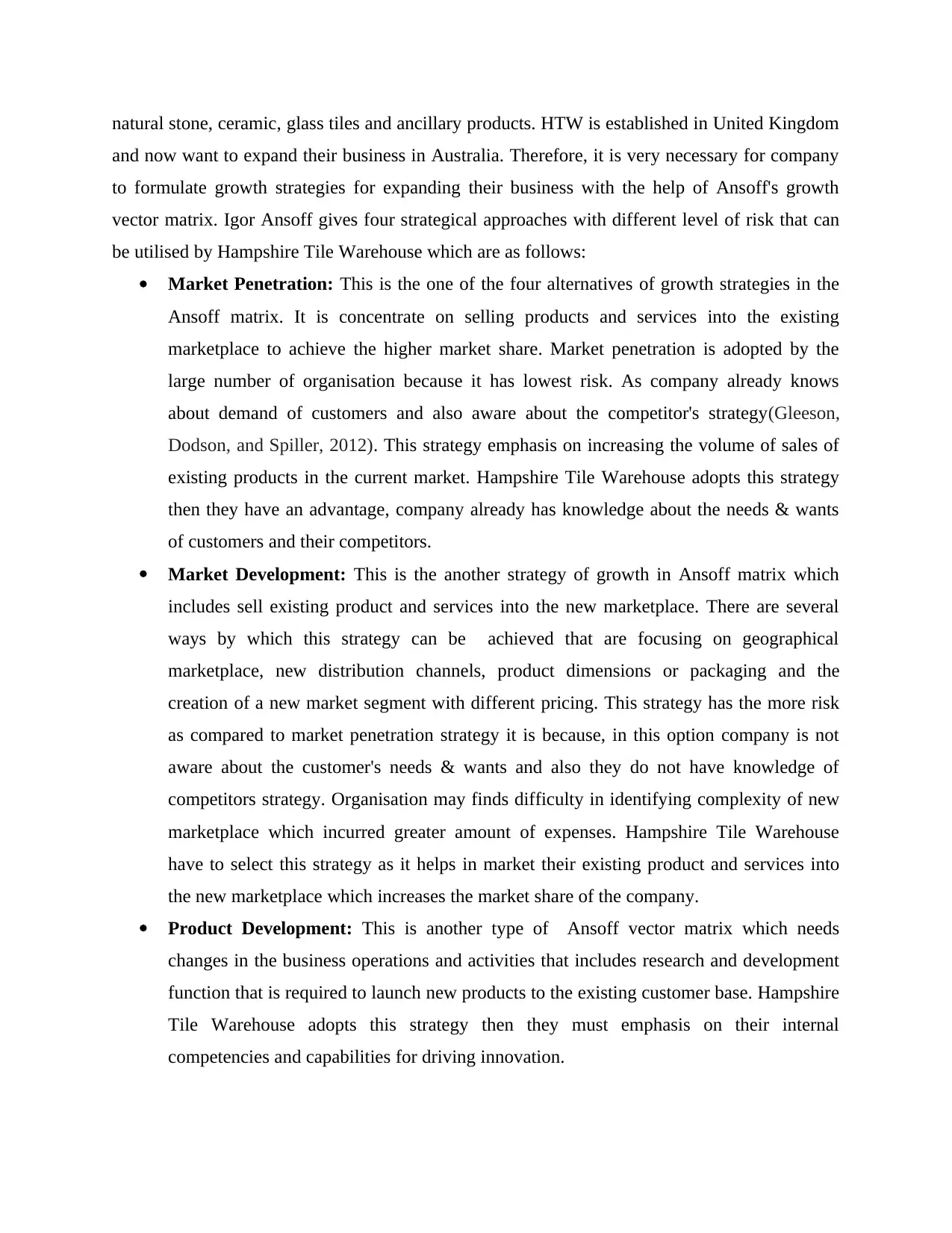
natural stone, ceramic, glass tiles and ancillary products. HTW is established in United Kingdom
and now want to expand their business in Australia. Therefore, it is very necessary for company
to formulate growth strategies for expanding their business with the help of Ansoff's growth
vector matrix. Igor Ansoff gives four strategical approaches with different level of risk that can
be utilised by Hampshire Tile Warehouse which are as follows:
Market Penetration: This is the one of the four alternatives of growth strategies in the
Ansoff matrix. It is concentrate on selling products and services into the existing
marketplace to achieve the higher market share. Market penetration is adopted by the
large number of organisation because it has lowest risk. As company already knows
about demand of customers and also aware about the competitor's strategy(Gleeson,
Dodson, and Spiller, 2012). This strategy emphasis on increasing the volume of sales of
existing products in the current market. Hampshire Tile Warehouse adopts this strategy
then they have an advantage, company already has knowledge about the needs & wants
of customers and their competitors.
Market Development: This is the another strategy of growth in Ansoff matrix which
includes sell existing product and services into the new marketplace. There are several
ways by which this strategy can be achieved that are focusing on geographical
marketplace, new distribution channels, product dimensions or packaging and the
creation of a new market segment with different pricing. This strategy has the more risk
as compared to market penetration strategy it is because, in this option company is not
aware about the customer's needs & wants and also they do not have knowledge of
competitors strategy. Organisation may finds difficulty in identifying complexity of new
marketplace which incurred greater amount of expenses. Hampshire Tile Warehouse
have to select this strategy as it helps in market their existing product and services into
the new marketplace which increases the market share of the company.
Product Development: This is another type of Ansoff vector matrix which needs
changes in the business operations and activities that includes research and development
function that is required to launch new products to the existing customer base. Hampshire
Tile Warehouse adopts this strategy then they must emphasis on their internal
competencies and capabilities for driving innovation.
and now want to expand their business in Australia. Therefore, it is very necessary for company
to formulate growth strategies for expanding their business with the help of Ansoff's growth
vector matrix. Igor Ansoff gives four strategical approaches with different level of risk that can
be utilised by Hampshire Tile Warehouse which are as follows:
Market Penetration: This is the one of the four alternatives of growth strategies in the
Ansoff matrix. It is concentrate on selling products and services into the existing
marketplace to achieve the higher market share. Market penetration is adopted by the
large number of organisation because it has lowest risk. As company already knows
about demand of customers and also aware about the competitor's strategy(Gleeson,
Dodson, and Spiller, 2012). This strategy emphasis on increasing the volume of sales of
existing products in the current market. Hampshire Tile Warehouse adopts this strategy
then they have an advantage, company already has knowledge about the needs & wants
of customers and their competitors.
Market Development: This is the another strategy of growth in Ansoff matrix which
includes sell existing product and services into the new marketplace. There are several
ways by which this strategy can be achieved that are focusing on geographical
marketplace, new distribution channels, product dimensions or packaging and the
creation of a new market segment with different pricing. This strategy has the more risk
as compared to market penetration strategy it is because, in this option company is not
aware about the customer's needs & wants and also they do not have knowledge of
competitors strategy. Organisation may finds difficulty in identifying complexity of new
marketplace which incurred greater amount of expenses. Hampshire Tile Warehouse
have to select this strategy as it helps in market their existing product and services into
the new marketplace which increases the market share of the company.
Product Development: This is another type of Ansoff vector matrix which needs
changes in the business operations and activities that includes research and development
function that is required to launch new products to the existing customer base. Hampshire
Tile Warehouse adopts this strategy then they must emphasis on their internal
competencies and capabilities for driving innovation.

Diversification: It is the most risky strategy among the all strategies of Ansoff vector
matrix as in this option there is launch of product in the new marketplace but it has a
potential to earn highest returns. Hampshire Tile Warehouse may select this option by
expanding its operations with new product and services in the new market.
These are the strategies of growth opportunities of Ansoff's vector matrix which helps
company in expanding there business. The best suitable strategy adopted by Hampshire tile
Warehouse is 'market development'. In this option organisation expand their business in
Australia and increase their market share with existing products.
M1. Options for growth and achieving competitive advantage
Ansoff's vector matrix is helpful in analysing the opportunities for growth and
development of an organisation. Igor Ansoff suggested four types of growth option. Market
development is most suitable strategy that can be adopted by Hampshire Tile warehouse as
company wants to expand their business in other country with existing products. To achieve
competitive advantage, company selects cost focus strategy in which company distributes their
products in niche market with lowest price.
D1. Critical evaluation of various growth options for expansions
According to Goodfellow, 2013, there are different option of growth for the expansion of
an organisation. Diversification and market development has more risk as compared to market
penetration and product differentiation. Company must adopt market development that helps
organisation in expansions with existing products and services.
TASK 2
P3. Potential sources of funding with their advantages and disadvantage
Business performs various operations for the proper functioning of an organisation which
requires money to finance these activities. So company have to decide which source of fund can
be selected for raising funds to perform various actions. There are type of sources of fund which
is broadly divided into two parts that are:
Internal sources: Finance that can be raised within the organisation are to be considered as
sources of fund. Internal sources involves sales of asset, reduction of working capital and retain
earning.
matrix as in this option there is launch of product in the new marketplace but it has a
potential to earn highest returns. Hampshire Tile Warehouse may select this option by
expanding its operations with new product and services in the new market.
These are the strategies of growth opportunities of Ansoff's vector matrix which helps
company in expanding there business. The best suitable strategy adopted by Hampshire tile
Warehouse is 'market development'. In this option organisation expand their business in
Australia and increase their market share with existing products.
M1. Options for growth and achieving competitive advantage
Ansoff's vector matrix is helpful in analysing the opportunities for growth and
development of an organisation. Igor Ansoff suggested four types of growth option. Market
development is most suitable strategy that can be adopted by Hampshire Tile warehouse as
company wants to expand their business in other country with existing products. To achieve
competitive advantage, company selects cost focus strategy in which company distributes their
products in niche market with lowest price.
D1. Critical evaluation of various growth options for expansions
According to Goodfellow, 2013, there are different option of growth for the expansion of
an organisation. Diversification and market development has more risk as compared to market
penetration and product differentiation. Company must adopt market development that helps
organisation in expansions with existing products and services.
TASK 2
P3. Potential sources of funding with their advantages and disadvantage
Business performs various operations for the proper functioning of an organisation which
requires money to finance these activities. So company have to decide which source of fund can
be selected for raising funds to perform various actions. There are type of sources of fund which
is broadly divided into two parts that are:
Internal sources: Finance that can be raised within the organisation are to be considered as
sources of fund. Internal sources involves sales of asset, reduction of working capital and retain
earning.
Paraphrase This Document
Need a fresh take? Get an instant paraphrase of this document with our AI Paraphraser

External sources: It includes the finance option that are available outside the business for raising
fund. External sources of funds are equity capital, debentures, leasing, hire purchase, bank loan,
crowdfunding and more.
There are various sources that can be adopted by Hampshire Tile Warehouse are as follows: Bank loan: It is the amount of fund that can be borrowed from the bank and the amount
is payable by the firm in future along with interest. It is a type of credit that can be given
on fix period of time span and on maturity the amount has to be repaid. Repayment
amount of fund is decided on the basis of its size, rate of interest and time period of loan.
Advantages: One of the major advantage of bank loan is that it provides tax benefit. Company
pays interest on the loan that is tax deducted.
Disadvantage: Drawback of this option of raising fund is banks charges pre payment loan
penalty and when firm borrows too much from bank then there is decrease in cash flow. Overdraft: It is the another option of raising fund which refers to amount of money that
bank allows their loyal customers to overdraw from current account (Hollenbeck, Noe
and Gerhart, 2018). The over withdrawal charges are different and it only depends on the
bank rate.
Advantages: It is good for company that includes greater movement of cash flow and also
helpful in tackling mismatch in flow of fund. Bank overdraft is useful in maintaining cash flow.
Disadvantage: one of the major drawback of this option is the interest rate of bank overdraft is
very flexible and it become difficult to estimate budget. Crowdfunding: This type of source of fund is used to raising funds from the large
number of people who are contributing a small amount via internet.
Advantages: Benefit of this option is that it is the fastest way of raising fund with no hidden fees
and company also get platform to market their products & services along with get an attention
through media.
Disadvantage: limitation of this option is it is most risky source of finance as when business fails
in project then it affects the goodwill of company and it is very time consuming process. Angel Financing: This is another type of source of fund in this option investor provide
finance to enterprise in order to gain equity position within the company. Angel investors
inject capital in firm by creating network to pool money or through crowdfunding
platform online.
fund. External sources of funds are equity capital, debentures, leasing, hire purchase, bank loan,
crowdfunding and more.
There are various sources that can be adopted by Hampshire Tile Warehouse are as follows: Bank loan: It is the amount of fund that can be borrowed from the bank and the amount
is payable by the firm in future along with interest. It is a type of credit that can be given
on fix period of time span and on maturity the amount has to be repaid. Repayment
amount of fund is decided on the basis of its size, rate of interest and time period of loan.
Advantages: One of the major advantage of bank loan is that it provides tax benefit. Company
pays interest on the loan that is tax deducted.
Disadvantage: Drawback of this option of raising fund is banks charges pre payment loan
penalty and when firm borrows too much from bank then there is decrease in cash flow. Overdraft: It is the another option of raising fund which refers to amount of money that
bank allows their loyal customers to overdraw from current account (Hollenbeck, Noe
and Gerhart, 2018). The over withdrawal charges are different and it only depends on the
bank rate.
Advantages: It is good for company that includes greater movement of cash flow and also
helpful in tackling mismatch in flow of fund. Bank overdraft is useful in maintaining cash flow.
Disadvantage: one of the major drawback of this option is the interest rate of bank overdraft is
very flexible and it become difficult to estimate budget. Crowdfunding: This type of source of fund is used to raising funds from the large
number of people who are contributing a small amount via internet.
Advantages: Benefit of this option is that it is the fastest way of raising fund with no hidden fees
and company also get platform to market their products & services along with get an attention
through media.
Disadvantage: limitation of this option is it is most risky source of finance as when business fails
in project then it affects the goodwill of company and it is very time consuming process. Angel Financing: This is another type of source of fund in this option investor provide
finance to enterprise in order to gain equity position within the company. Angel investors
inject capital in firm by creating network to pool money or through crowdfunding
platform online.
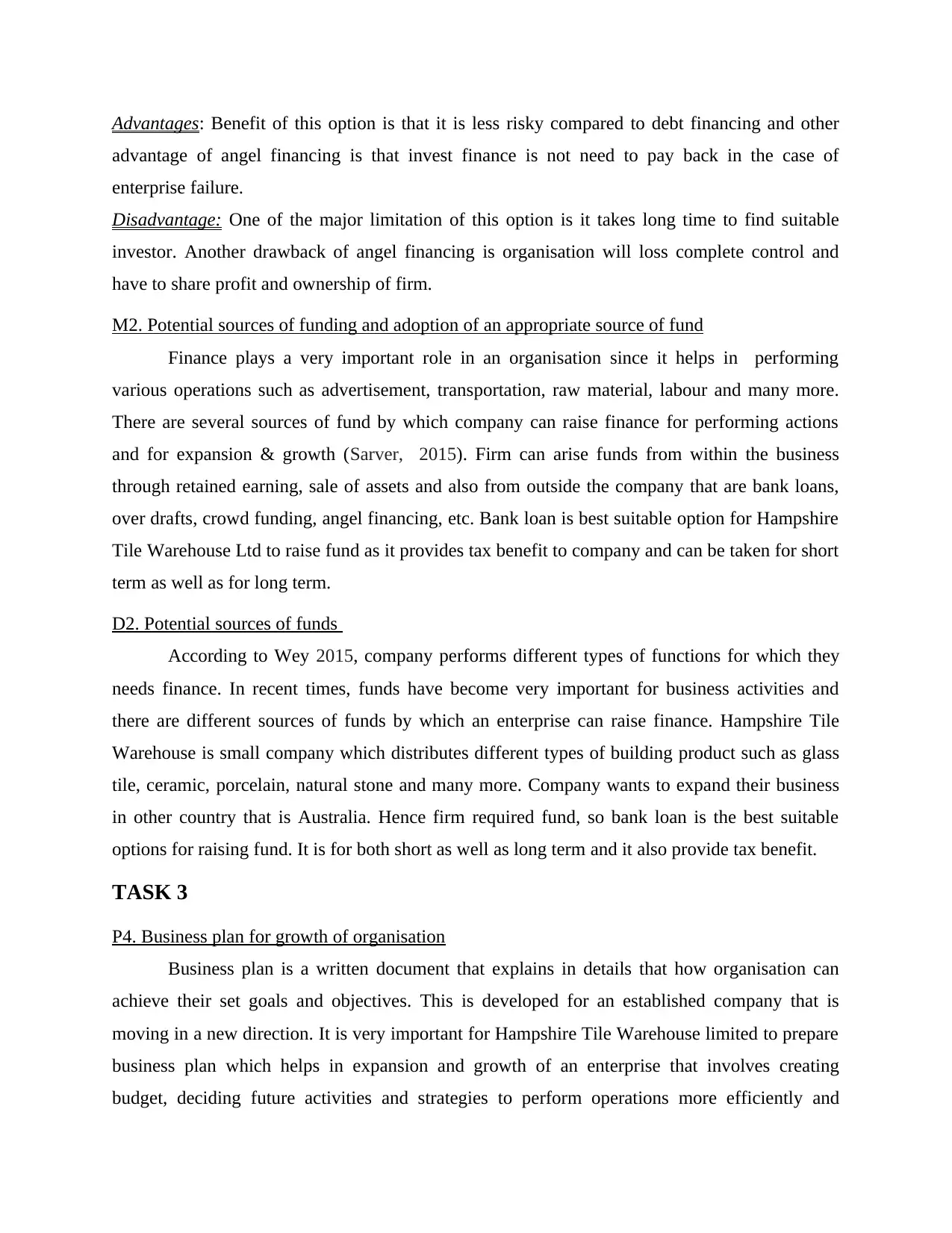
Advantages: Benefit of this option is that it is less risky compared to debt financing and other
advantage of angel financing is that invest finance is not need to pay back in the case of
enterprise failure.
Disadvantage: One of the major limitation of this option is it takes long time to find suitable
investor. Another drawback of angel financing is organisation will loss complete control and
have to share profit and ownership of firm.
M2. Potential sources of funding and adoption of an appropriate source of fund
Finance plays a very important role in an organisation since it helps in performing
various operations such as advertisement, transportation, raw material, labour and many more.
There are several sources of fund by which company can raise finance for performing actions
and for expansion & growth (Sarver, 2015). Firm can arise funds from within the business
through retained earning, sale of assets and also from outside the company that are bank loans,
over drafts, crowd funding, angel financing, etc. Bank loan is best suitable option for Hampshire
Tile Warehouse Ltd to raise fund as it provides tax benefit to company and can be taken for short
term as well as for long term.
D2. Potential sources of funds
According to Wey 2015, company performs different types of functions for which they
needs finance. In recent times, funds have become very important for business activities and
there are different sources of funds by which an enterprise can raise finance. Hampshire Tile
Warehouse is small company which distributes different types of building product such as glass
tile, ceramic, porcelain, natural stone and many more. Company wants to expand their business
in other country that is Australia. Hence firm required fund, so bank loan is the best suitable
options for raising fund. It is for both short as well as long term and it also provide tax benefit.
TASK 3
P4. Business plan for growth of organisation
Business plan is a written document that explains in details that how organisation can
achieve their set goals and objectives. This is developed for an established company that is
moving in a new direction. It is very important for Hampshire Tile Warehouse limited to prepare
business plan which helps in expansion and growth of an enterprise that involves creating
budget, deciding future activities and strategies to perform operations more efficiently and
advantage of angel financing is that invest finance is not need to pay back in the case of
enterprise failure.
Disadvantage: One of the major limitation of this option is it takes long time to find suitable
investor. Another drawback of angel financing is organisation will loss complete control and
have to share profit and ownership of firm.
M2. Potential sources of funding and adoption of an appropriate source of fund
Finance plays a very important role in an organisation since it helps in performing
various operations such as advertisement, transportation, raw material, labour and many more.
There are several sources of fund by which company can raise finance for performing actions
and for expansion & growth (Sarver, 2015). Firm can arise funds from within the business
through retained earning, sale of assets and also from outside the company that are bank loans,
over drafts, crowd funding, angel financing, etc. Bank loan is best suitable option for Hampshire
Tile Warehouse Ltd to raise fund as it provides tax benefit to company and can be taken for short
term as well as for long term.
D2. Potential sources of funds
According to Wey 2015, company performs different types of functions for which they
needs finance. In recent times, funds have become very important for business activities and
there are different sources of funds by which an enterprise can raise finance. Hampshire Tile
Warehouse is small company which distributes different types of building product such as glass
tile, ceramic, porcelain, natural stone and many more. Company wants to expand their business
in other country that is Australia. Hence firm required fund, so bank loan is the best suitable
options for raising fund. It is for both short as well as long term and it also provide tax benefit.
TASK 3
P4. Business plan for growth of organisation
Business plan is a written document that explains in details that how organisation can
achieve their set goals and objectives. This is developed for an established company that is
moving in a new direction. It is very important for Hampshire Tile Warehouse limited to prepare
business plan which helps in expansion and growth of an enterprise that involves creating
budget, deciding future activities and strategies to perform operations more efficiently and
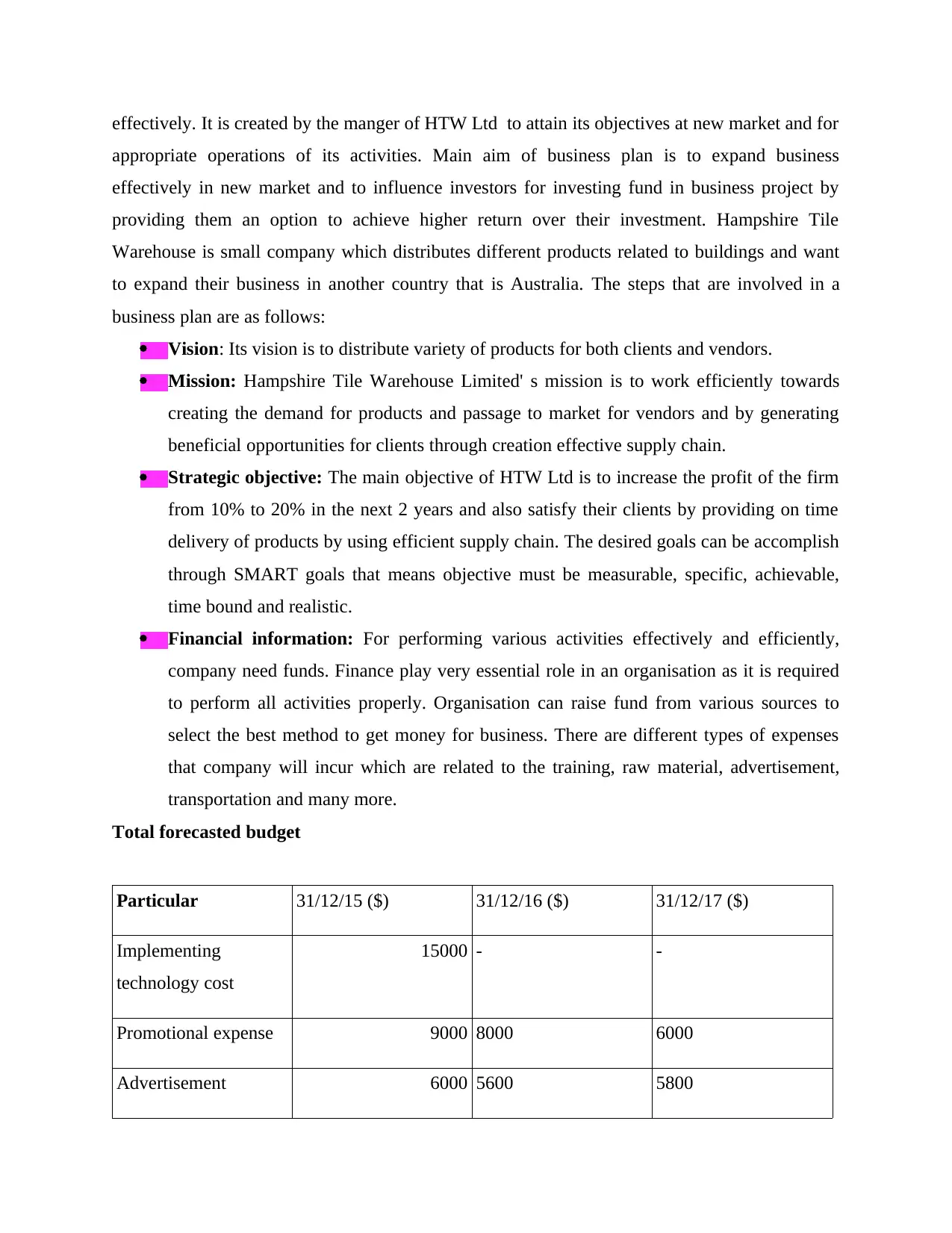
effectively. It is created by the manger of HTW Ltd to attain its objectives at new market and for
appropriate operations of its activities. Main aim of business plan is to expand business
effectively in new market and to influence investors for investing fund in business project by
providing them an option to achieve higher return over their investment. Hampshire Tile
Warehouse is small company which distributes different products related to buildings and want
to expand their business in another country that is Australia. The steps that are involved in a
business plan are as follows:
Vision: Its vision is to distribute variety of products for both clients and vendors.
Mission: Hampshire Tile Warehouse Limited' s mission is to work efficiently towards
creating the demand for products and passage to market for vendors and by generating
beneficial opportunities for clients through creation effective supply chain.
Strategic objective: The main objective of HTW Ltd is to increase the profit of the firm
from 10% to 20% in the next 2 years and also satisfy their clients by providing on time
delivery of products by using efficient supply chain. The desired goals can be accomplish
through SMART goals that means objective must be measurable, specific, achievable,
time bound and realistic.
Financial information: For performing various activities effectively and efficiently,
company need funds. Finance play very essential role in an organisation as it is required
to perform all activities properly. Organisation can raise fund from various sources to
select the best method to get money for business. There are different types of expenses
that company will incur which are related to the training, raw material, advertisement,
transportation and many more.
Total forecasted budget
Particular 31/12/15 ($) 31/12/16 ($) 31/12/17 ($)
Implementing
technology cost
15000 - -
Promotional expense 9000 8000 6000
Advertisement 6000 5600 5800
appropriate operations of its activities. Main aim of business plan is to expand business
effectively in new market and to influence investors for investing fund in business project by
providing them an option to achieve higher return over their investment. Hampshire Tile
Warehouse is small company which distributes different products related to buildings and want
to expand their business in another country that is Australia. The steps that are involved in a
business plan are as follows:
Vision: Its vision is to distribute variety of products for both clients and vendors.
Mission: Hampshire Tile Warehouse Limited' s mission is to work efficiently towards
creating the demand for products and passage to market for vendors and by generating
beneficial opportunities for clients through creation effective supply chain.
Strategic objective: The main objective of HTW Ltd is to increase the profit of the firm
from 10% to 20% in the next 2 years and also satisfy their clients by providing on time
delivery of products by using efficient supply chain. The desired goals can be accomplish
through SMART goals that means objective must be measurable, specific, achievable,
time bound and realistic.
Financial information: For performing various activities effectively and efficiently,
company need funds. Finance play very essential role in an organisation as it is required
to perform all activities properly. Organisation can raise fund from various sources to
select the best method to get money for business. There are different types of expenses
that company will incur which are related to the training, raw material, advertisement,
transportation and many more.
Total forecasted budget
Particular 31/12/15 ($) 31/12/16 ($) 31/12/17 ($)
Implementing
technology cost
15000 - -
Promotional expense 9000 8000 6000
Advertisement 6000 5600 5800
Secure Best Marks with AI Grader
Need help grading? Try our AI Grader for instant feedback on your assignments.
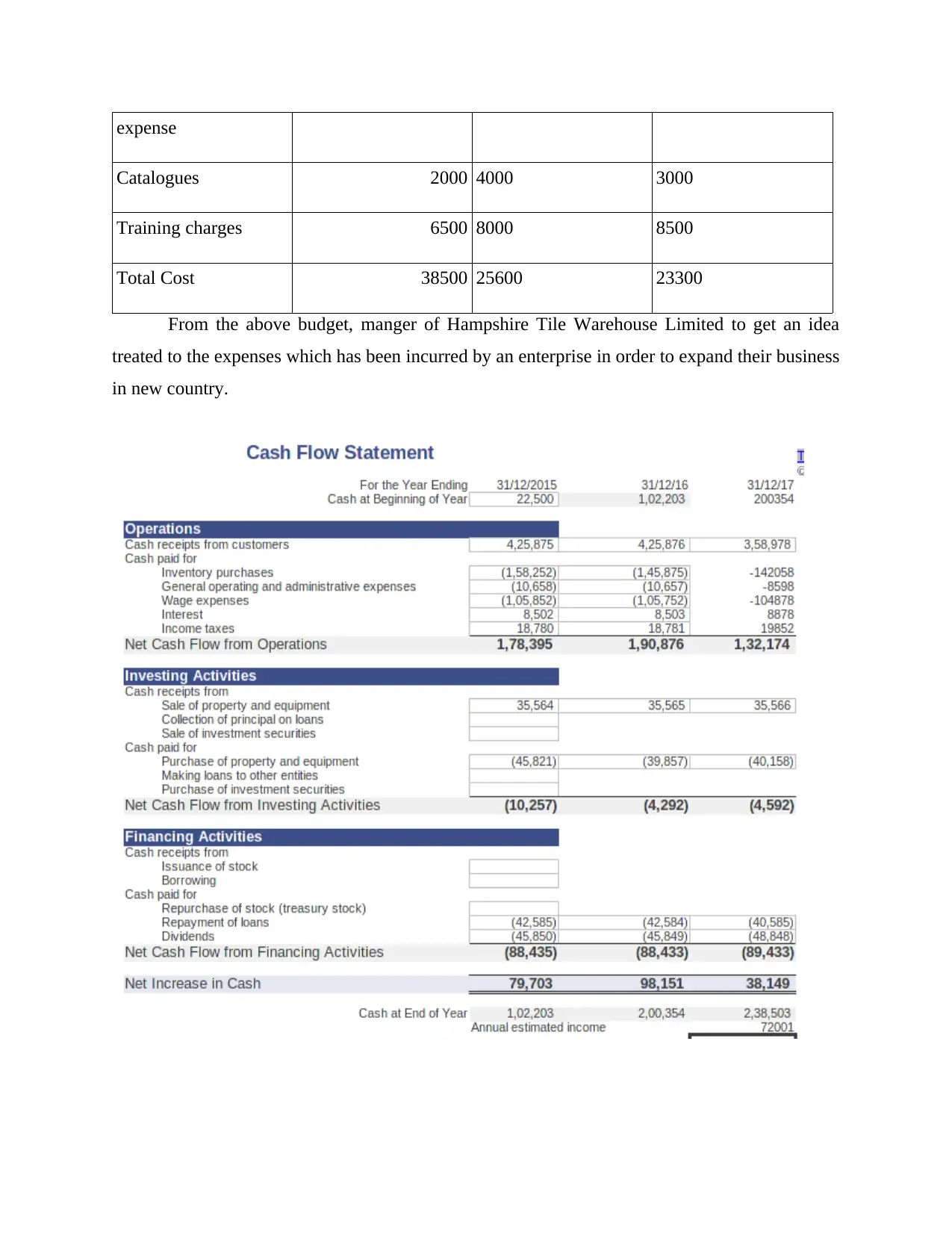
expense
Catalogues 2000 4000 3000
Training charges 6500 8000 8500
Total Cost 38500 25600 23300
From the above budget, manger of Hampshire Tile Warehouse Limited to get an idea
treated to the expenses which has been incurred by an enterprise in order to expand their business
in new country.
Catalogues 2000 4000 3000
Training charges 6500 8000 8500
Total Cost 38500 25600 23300
From the above budget, manger of Hampshire Tile Warehouse Limited to get an idea
treated to the expenses which has been incurred by an enterprise in order to expand their business
in new country.

Above cash flow shows that firm has enough funds that can be used for the paying off
their liabilities and debts. Hampshire Tile Warehouse Ltd have to pay taxes that may be change
every year. At last, cash in hand for the year 2015, 2016 and 2017 that are $102203, $200354,
$238503 respectively and average income is estimated for three year is $72001.
M3. Develop an appropriate and detailed business plan for growth
Business plan is a written document which describes about the future plan. It includes
vision, mission, strategic objective and also about financial information of the Hampshire Tile
Warehouse limited. It is very essential to develop business plan which helps in achieving set
goals and objectives.
D3. Business plan to achieve organisational objective
Business plan is a document that describes about how an organisation is going to achieve
company's goals. Before formulating business plan, a manager must consider various factors
such as strategic objective, mission and vision so that it helps in attaining business objective.
TASK 4
P5 Succession and exit plan for small business with its advantage and disadvantage
As Hampshire Tile Warehouse Ltd want to expand its business so it is very essential for
them to formulate a proper succession plan which help in dealing with unexpected event that
may occur during future course of actions (Lewis, 2013). Before formulating succession and exit
strategy, a manager must consider various factors such as objective, visions and mission of the
company. These plan will help Hampshire Tile Warehouse Ltd in effective functioning of
business operations.
Different ways of succession and exit business
When a company wants to expand its business in new market then it is very essential for
them to formulate the strategies for its success. There may be some issues that may arise in
future and affect the Hampshire Tile Warehouse Ltd in achieving their set targets and objectives
In order to overcome from these issue, company must formulate an exit plan. There are number
of exit and succession plan which are explained below:
Exit options:
their liabilities and debts. Hampshire Tile Warehouse Ltd have to pay taxes that may be change
every year. At last, cash in hand for the year 2015, 2016 and 2017 that are $102203, $200354,
$238503 respectively and average income is estimated for three year is $72001.
M3. Develop an appropriate and detailed business plan for growth
Business plan is a written document which describes about the future plan. It includes
vision, mission, strategic objective and also about financial information of the Hampshire Tile
Warehouse limited. It is very essential to develop business plan which helps in achieving set
goals and objectives.
D3. Business plan to achieve organisational objective
Business plan is a document that describes about how an organisation is going to achieve
company's goals. Before formulating business plan, a manager must consider various factors
such as strategic objective, mission and vision so that it helps in attaining business objective.
TASK 4
P5 Succession and exit plan for small business with its advantage and disadvantage
As Hampshire Tile Warehouse Ltd want to expand its business so it is very essential for
them to formulate a proper succession plan which help in dealing with unexpected event that
may occur during future course of actions (Lewis, 2013). Before formulating succession and exit
strategy, a manager must consider various factors such as objective, visions and mission of the
company. These plan will help Hampshire Tile Warehouse Ltd in effective functioning of
business operations.
Different ways of succession and exit business
When a company wants to expand its business in new market then it is very essential for
them to formulate the strategies for its success. There may be some issues that may arise in
future and affect the Hampshire Tile Warehouse Ltd in achieving their set targets and objectives
In order to overcome from these issue, company must formulate an exit plan. There are number
of exit and succession plan which are explained below:
Exit options:
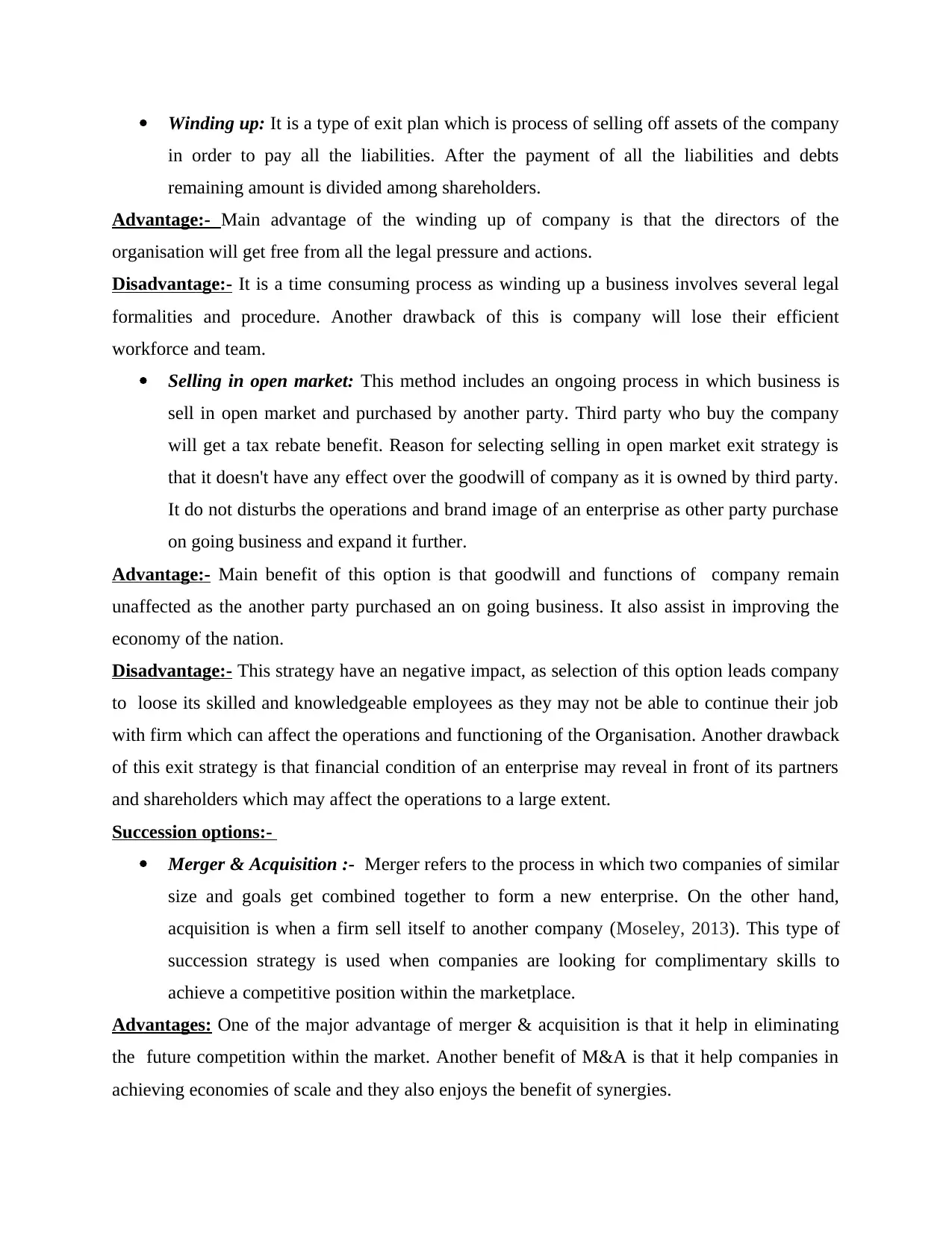
Winding up: It is a type of exit plan which is process of selling off assets of the company
in order to pay all the liabilities. After the payment of all the liabilities and debts
remaining amount is divided among shareholders.
Advantage:- Main advantage of the winding up of company is that the directors of the
organisation will get free from all the legal pressure and actions.
Disadvantage:- It is a time consuming process as winding up a business involves several legal
formalities and procedure. Another drawback of this is company will lose their efficient
workforce and team.
Selling in open market: This method includes an ongoing process in which business is
sell in open market and purchased by another party. Third party who buy the company
will get a tax rebate benefit. Reason for selecting selling in open market exit strategy is
that it doesn't have any effect over the goodwill of company as it is owned by third party.
It do not disturbs the operations and brand image of an enterprise as other party purchase
on going business and expand it further.
Advantage:- Main benefit of this option is that goodwill and functions of company remain
unaffected as the another party purchased an on going business. It also assist in improving the
economy of the nation.
Disadvantage:- This strategy have an negative impact, as selection of this option leads company
to loose its skilled and knowledgeable employees as they may not be able to continue their job
with firm which can affect the operations and functioning of the Organisation. Another drawback
of this exit strategy is that financial condition of an enterprise may reveal in front of its partners
and shareholders which may affect the operations to a large extent.
Succession options:-
Merger & Acquisition :- Merger refers to the process in which two companies of similar
size and goals get combined together to form a new enterprise. On the other hand,
acquisition is when a firm sell itself to another company (Moseley, 2013). This type of
succession strategy is used when companies are looking for complimentary skills to
achieve a competitive position within the marketplace.
Advantages: One of the major advantage of merger & acquisition is that it help in eliminating
the future competition within the market. Another benefit of M&A is that it help companies in
achieving economies of scale and they also enjoys the benefit of synergies.
in order to pay all the liabilities. After the payment of all the liabilities and debts
remaining amount is divided among shareholders.
Advantage:- Main advantage of the winding up of company is that the directors of the
organisation will get free from all the legal pressure and actions.
Disadvantage:- It is a time consuming process as winding up a business involves several legal
formalities and procedure. Another drawback of this is company will lose their efficient
workforce and team.
Selling in open market: This method includes an ongoing process in which business is
sell in open market and purchased by another party. Third party who buy the company
will get a tax rebate benefit. Reason for selecting selling in open market exit strategy is
that it doesn't have any effect over the goodwill of company as it is owned by third party.
It do not disturbs the operations and brand image of an enterprise as other party purchase
on going business and expand it further.
Advantage:- Main benefit of this option is that goodwill and functions of company remain
unaffected as the another party purchased an on going business. It also assist in improving the
economy of the nation.
Disadvantage:- This strategy have an negative impact, as selection of this option leads company
to loose its skilled and knowledgeable employees as they may not be able to continue their job
with firm which can affect the operations and functioning of the Organisation. Another drawback
of this exit strategy is that financial condition of an enterprise may reveal in front of its partners
and shareholders which may affect the operations to a large extent.
Succession options:-
Merger & Acquisition :- Merger refers to the process in which two companies of similar
size and goals get combined together to form a new enterprise. On the other hand,
acquisition is when a firm sell itself to another company (Moseley, 2013). This type of
succession strategy is used when companies are looking for complimentary skills to
achieve a competitive position within the marketplace.
Advantages: One of the major advantage of merger & acquisition is that it help in eliminating
the future competition within the market. Another benefit of M&A is that it help companies in
achieving economies of scale and they also enjoys the benefit of synergies.
Paraphrase This Document
Need a fresh take? Get an instant paraphrase of this document with our AI Paraphraser
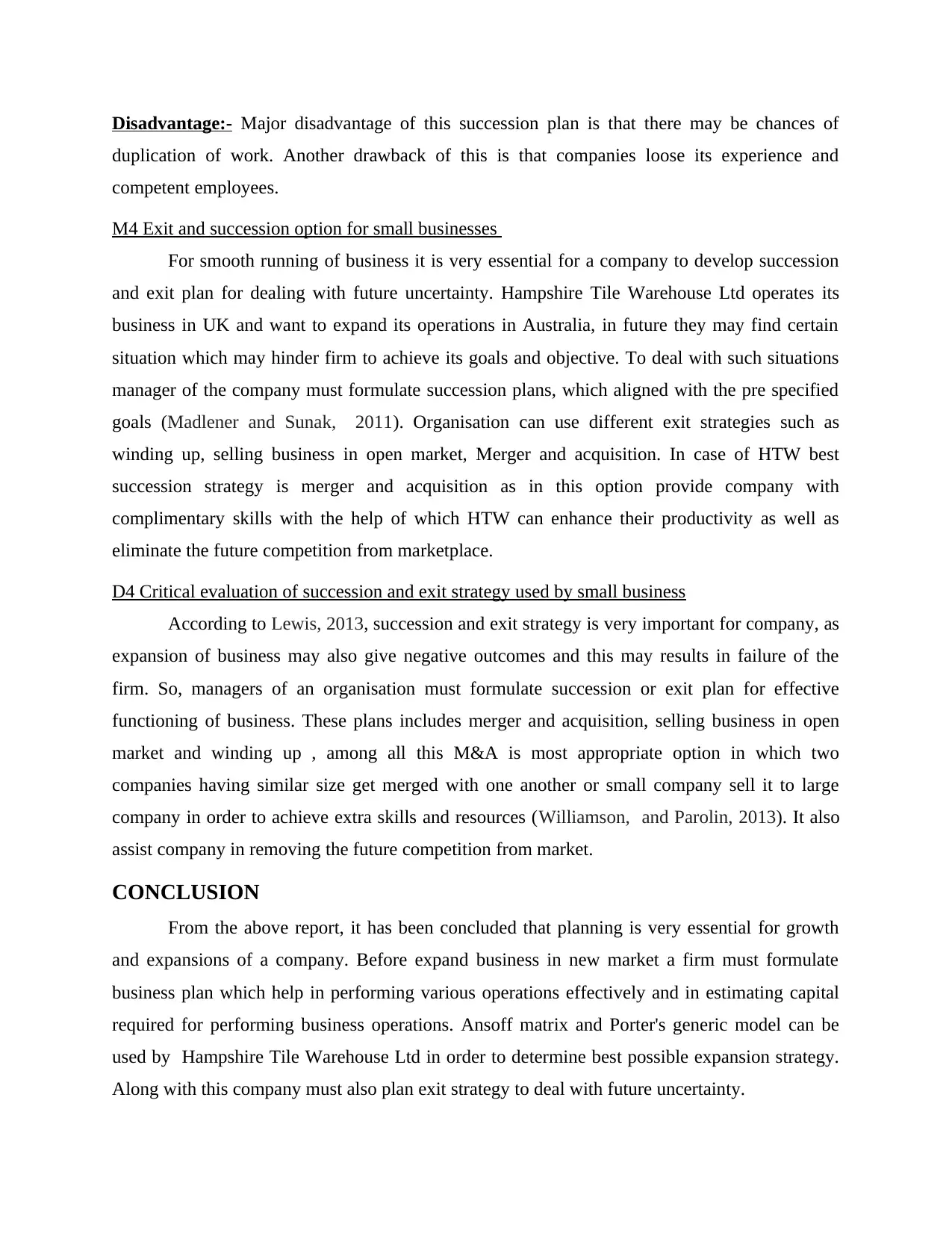
Disadvantage:- Major disadvantage of this succession plan is that there may be chances of
duplication of work. Another drawback of this is that companies loose its experience and
competent employees.
M4 Exit and succession option for small businesses
For smooth running of business it is very essential for a company to develop succession
and exit plan for dealing with future uncertainty. Hampshire Tile Warehouse Ltd operates its
business in UK and want to expand its operations in Australia, in future they may find certain
situation which may hinder firm to achieve its goals and objective. To deal with such situations
manager of the company must formulate succession plans, which aligned with the pre specified
goals (Madlener and Sunak, 2011). Organisation can use different exit strategies such as
winding up, selling business in open market, Merger and acquisition. In case of HTW best
succession strategy is merger and acquisition as in this option provide company with
complimentary skills with the help of which HTW can enhance their productivity as well as
eliminate the future competition from marketplace.
D4 Critical evaluation of succession and exit strategy used by small business
According to Lewis, 2013, succession and exit strategy is very important for company, as
expansion of business may also give negative outcomes and this may results in failure of the
firm. So, managers of an organisation must formulate succession or exit plan for effective
functioning of business. These plans includes merger and acquisition, selling business in open
market and winding up , among all this M&A is most appropriate option in which two
companies having similar size get merged with one another or small company sell it to large
company in order to achieve extra skills and resources (Williamson, and Parolin, 2013). It also
assist company in removing the future competition from market.
CONCLUSION
From the above report, it has been concluded that planning is very essential for growth
and expansions of a company. Before expand business in new market a firm must formulate
business plan which help in performing various operations effectively and in estimating capital
required for performing business operations. Ansoff matrix and Porter's generic model can be
used by Hampshire Tile Warehouse Ltd in order to determine best possible expansion strategy.
Along with this company must also plan exit strategy to deal with future uncertainty.
duplication of work. Another drawback of this is that companies loose its experience and
competent employees.
M4 Exit and succession option for small businesses
For smooth running of business it is very essential for a company to develop succession
and exit plan for dealing with future uncertainty. Hampshire Tile Warehouse Ltd operates its
business in UK and want to expand its operations in Australia, in future they may find certain
situation which may hinder firm to achieve its goals and objective. To deal with such situations
manager of the company must formulate succession plans, which aligned with the pre specified
goals (Madlener and Sunak, 2011). Organisation can use different exit strategies such as
winding up, selling business in open market, Merger and acquisition. In case of HTW best
succession strategy is merger and acquisition as in this option provide company with
complimentary skills with the help of which HTW can enhance their productivity as well as
eliminate the future competition from marketplace.
D4 Critical evaluation of succession and exit strategy used by small business
According to Lewis, 2013, succession and exit strategy is very important for company, as
expansion of business may also give negative outcomes and this may results in failure of the
firm. So, managers of an organisation must formulate succession or exit plan for effective
functioning of business. These plans includes merger and acquisition, selling business in open
market and winding up , among all this M&A is most appropriate option in which two
companies having similar size get merged with one another or small company sell it to large
company in order to achieve extra skills and resources (Williamson, and Parolin, 2013). It also
assist company in removing the future competition from market.
CONCLUSION
From the above report, it has been concluded that planning is very essential for growth
and expansions of a company. Before expand business in new market a firm must formulate
business plan which help in performing various operations effectively and in estimating capital
required for performing business operations. Ansoff matrix and Porter's generic model can be
used by Hampshire Tile Warehouse Ltd in order to determine best possible expansion strategy.
Along with this company must also plan exit strategy to deal with future uncertainty.
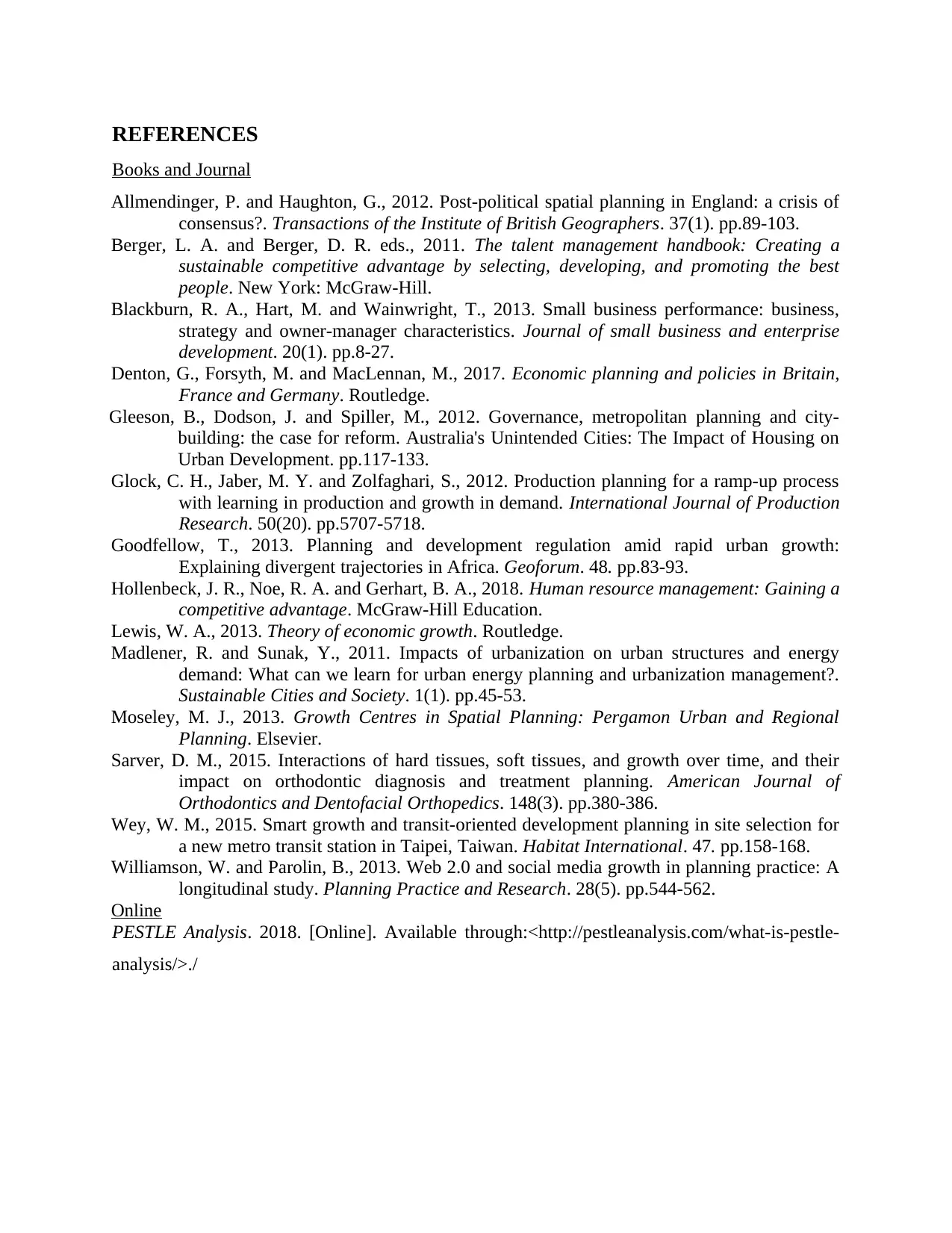
REFERENCES
Books and Journal
Allmendinger, P. and Haughton, G., 2012. Post‐political spatial planning in England: a crisis of
consensus?. Transactions of the Institute of British Geographers. 37(1). pp.89-103.
Berger, L. A. and Berger, D. R. eds., 2011. The talent management handbook: Creating a
sustainable competitive advantage by selecting, developing, and promoting the best
people. New York: McGraw-Hill.
Blackburn, R. A., Hart, M. and Wainwright, T., 2013. Small business performance: business,
strategy and owner-manager characteristics. Journal of small business and enterprise
development. 20(1). pp.8-27.
Denton, G., Forsyth, M. and MacLennan, M., 2017. Economic planning and policies in Britain,
France and Germany. Routledge.
Gleeson, B., Dodson, J. and Spiller, M., 2012. Governance, metropolitan planning and city-
building: the case for reform. Australia's Unintended Cities: The Impact of Housing on
Urban Development. pp.117-133.
Glock, C. H., Jaber, M. Y. and Zolfaghari, S., 2012. Production planning for a ramp-up process
with learning in production and growth in demand. International Journal of Production
Research. 50(20). pp.5707-5718.
Goodfellow, T., 2013. Planning and development regulation amid rapid urban growth:
Explaining divergent trajectories in Africa. Geoforum. 48. pp.83-93.
Hollenbeck, J. R., Noe, R. A. and Gerhart, B. A., 2018. Human resource management: Gaining a
competitive advantage. McGraw-Hill Education.
Lewis, W. A., 2013. Theory of economic growth. Routledge.
Madlener, R. and Sunak, Y., 2011. Impacts of urbanization on urban structures and energy
demand: What can we learn for urban energy planning and urbanization management?.
Sustainable Cities and Society. 1(1). pp.45-53.
Moseley, M. J., 2013. Growth Centres in Spatial Planning: Pergamon Urban and Regional
Planning. Elsevier.
Sarver, D. M., 2015. Interactions of hard tissues, soft tissues, and growth over time, and their
impact on orthodontic diagnosis and treatment planning. American Journal of
Orthodontics and Dentofacial Orthopedics. 148(3). pp.380-386.
Wey, W. M., 2015. Smart growth and transit-oriented development planning in site selection for
a new metro transit station in Taipei, Taiwan. Habitat International. 47. pp.158-168.
Williamson, W. and Parolin, B., 2013. Web 2.0 and social media growth in planning practice: A
longitudinal study. Planning Practice and Research. 28(5). pp.544-562.
Online
PESTLE Analysis. 2018. [Online]. Available through:<http://pestleanalysis.com/what-is-pestle-
analysis/>./
Books and Journal
Allmendinger, P. and Haughton, G., 2012. Post‐political spatial planning in England: a crisis of
consensus?. Transactions of the Institute of British Geographers. 37(1). pp.89-103.
Berger, L. A. and Berger, D. R. eds., 2011. The talent management handbook: Creating a
sustainable competitive advantage by selecting, developing, and promoting the best
people. New York: McGraw-Hill.
Blackburn, R. A., Hart, M. and Wainwright, T., 2013. Small business performance: business,
strategy and owner-manager characteristics. Journal of small business and enterprise
development. 20(1). pp.8-27.
Denton, G., Forsyth, M. and MacLennan, M., 2017. Economic planning and policies in Britain,
France and Germany. Routledge.
Gleeson, B., Dodson, J. and Spiller, M., 2012. Governance, metropolitan planning and city-
building: the case for reform. Australia's Unintended Cities: The Impact of Housing on
Urban Development. pp.117-133.
Glock, C. H., Jaber, M. Y. and Zolfaghari, S., 2012. Production planning for a ramp-up process
with learning in production and growth in demand. International Journal of Production
Research. 50(20). pp.5707-5718.
Goodfellow, T., 2013. Planning and development regulation amid rapid urban growth:
Explaining divergent trajectories in Africa. Geoforum. 48. pp.83-93.
Hollenbeck, J. R., Noe, R. A. and Gerhart, B. A., 2018. Human resource management: Gaining a
competitive advantage. McGraw-Hill Education.
Lewis, W. A., 2013. Theory of economic growth. Routledge.
Madlener, R. and Sunak, Y., 2011. Impacts of urbanization on urban structures and energy
demand: What can we learn for urban energy planning and urbanization management?.
Sustainable Cities and Society. 1(1). pp.45-53.
Moseley, M. J., 2013. Growth Centres in Spatial Planning: Pergamon Urban and Regional
Planning. Elsevier.
Sarver, D. M., 2015. Interactions of hard tissues, soft tissues, and growth over time, and their
impact on orthodontic diagnosis and treatment planning. American Journal of
Orthodontics and Dentofacial Orthopedics. 148(3). pp.380-386.
Wey, W. M., 2015. Smart growth and transit-oriented development planning in site selection for
a new metro transit station in Taipei, Taiwan. Habitat International. 47. pp.158-168.
Williamson, W. and Parolin, B., 2013. Web 2.0 and social media growth in planning practice: A
longitudinal study. Planning Practice and Research. 28(5). pp.544-562.
Online
PESTLE Analysis. 2018. [Online]. Available through:<http://pestleanalysis.com/what-is-pestle-
analysis/>./
1 out of 15
Related Documents
Your All-in-One AI-Powered Toolkit for Academic Success.
+13062052269
info@desklib.com
Available 24*7 on WhatsApp / Email
![[object Object]](/_next/static/media/star-bottom.7253800d.svg)
Unlock your academic potential
© 2024 | Zucol Services PVT LTD | All rights reserved.





